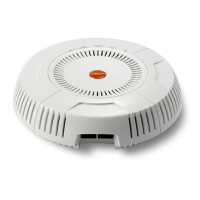Wireless Access Point
314 Configuring the Wireless AP
One of the IAPs must be set to monitor mode if you wish to support
Spectrum Analyzer, Radio Assurance (loopback testing), and Intrusion
Detection features. Monitoring has a Timeshare mode option, which is
especially useful for small APs with two IAPs allowing one IAP to be
shared between monitoring the airwaves for problems and providing
services to stations. See RF Monitor Mode in “Advanced RF Settings” on
page 357 to set this option.
4. In the WiFi Mode field, select the IEEE 802.11 wireless mode (or
combination) that you want to allow on this IAP. The drop-down list will
only display the appropriate choices for the selected Band. For example,
the 5 GHz band allows you to select ac-only, anac, an, a-only, or n-only,
while 2.4GHz includes 802.11b and 802.11g choices. When you select a
WiFi Mode for any IAP, your selection in the Channel column will be
checked to ensure that it is a valid choice for that WiFi Mode.
By selecting appropriate WiFi Modes for the radios on your APs, you can
greatly improve wireless network performance. For example, if you have
802.11n and 802.11ac stations using the same IAP, throughput on that
radio is reduced greatly for the 802.11ac stations. By supporting 802.11n
stations only on selected radios in your network, the rest of your 802.11ac
IAPs will have greatly improved performance. Take care to ensure that
your network provides adequate coverage for the types of stations that
you need to support.
5. In the Channel field, select the channel you want this IAP to use from the
channels available in the pull-down list. The list shows the channels
available for the IAP selected (depending on which band the IAP is
using). Channels that are shown in gray are unavailable. They are either
already in use, or not offered for the selected Band.
The channels that are available for assignment to IAPs will differ,
depending on the country of operation. If Country is set to United States
in the Global Settings window, then 21 channels are available to 802.11an
radios.

